Sparta and Mystras
Sparta and Mystras
One of our day-trips from Gytheio was to Sparta and Mystras. Sparta dominated the Peloponnesus between the ninth and the fourth centuries B.C. The Peloponnesian Wars were fought between Athens and Sparta in the fifth century B.C., a war that Sparta won. Spartan warriors were known for their ferocity, and they ruled the slaves who farmed the lands of the Peloponnesos with great cruelty. So it was surprising to see how little survives from ancient Sparta.
We visited the acropolis of Sparta, where the main buildings of the ancient city were located. There remain only a handful of ruined walls, ditches, and pillars.
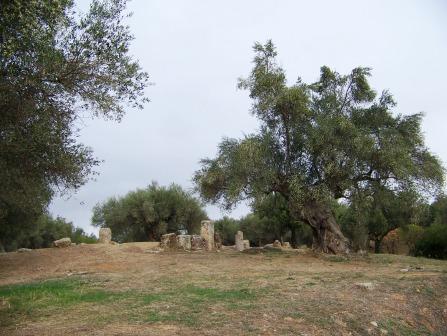


The modern city isn't all that exciting either. It is mostly very modern, postwar, and devoid of much character.
Then we found out what happened to Sparta. During the Middle Ages most of what was lying around--stone blocks, columns, and so on--were carried off to Mystras, a few miles away.
Mystras is built into the steep side of Mount Taigetos for better protection from attack. It was begun in 1249 A.D. by its French duke.
(A bit of a history lesson is in order: In 1204 much of the Byzantine Empire was conquered by western European warriors, who were supposed to be going on Crusade but who decided to take a bit of a detour for a different sort of military adventure--and better booty. The empire was divided up among the leaders of the campaign, each of whom gave themselves new and lofty titles--Duke of Athens, King of Constantinople, and so on. One of them was the Duke of Morea, which is what the Peloponnesos was then called. Since these Dukes feared an uprising among the Greek population, who probably weren't too happy to have been conquered by western Europeans, they eventually decided to build Mystras as a castle and town that would be difficult to take by force. Ironically, this Duke of Morea was captured in battle, and so only a decade later he gave possession of Mystras and its region back to the Byzantine Emperor as his ransom. Mystras continued to flourish, but as a Byzantine rather than French town.)

Mystras is beautifully situated, and we saw all sorts of georgeous vistas as we walked around the site.

Mystras is dominated by the ruins of its medieval castle at the top of the mountain.

Partway down the slope is the medieval palace, currently undergoing restoration.

From the vantagepoints provided by the slope, you can see the modern city of Sparta on the plain below.
The glory of Mystras are the churches, which have been preserved or restored from the Byzantine period.

The church of Saint Christopher was the largest of them.
Its exterior (above) shows the mix of French Romanesque and Greek Byzantine elements, since it includes the square stone belltower typical of western churches but also the multidomed roof and alternating patterns of brick and stone typical of eastern churches.


Its interior also shows this mix of western and eastern styles, since its
arched columns are typical of French
Romanesque churches but its circular domes pierced with windows are typical
of Greek Byzantine churches.
The frescoes also show a mix of east and west: here, the martyrdom of Saint
Demetrius.

The church of Saint Theodore was built later and is more wholly Byzantine
in look.
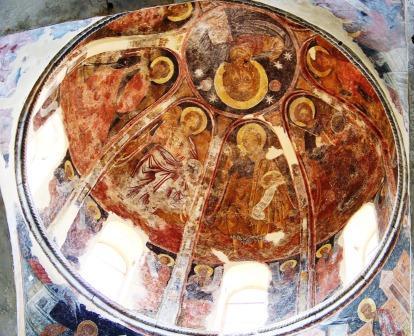
Painted into the interior of its large central dome are images of Christ (at
the center) surrounded by saints.

It is in the upper town, closest to the castle, where the western influences predominate, as in these ruined churches (above).

One of these churches is still home to a small group of Orthodox nuns, the
only current inhabitants of Mystras.

In fact, Mystras was still inhabited until
the beginning of the twentieth century, when its population moved to the modern
town of Sparta, looking for work.
In later "restoration" efforts, all of the modern additions and
changes to homes throughout the town were removed, so that apart from the
churches, the town is mostly in ruins.
Still, the overall experience is memorable.
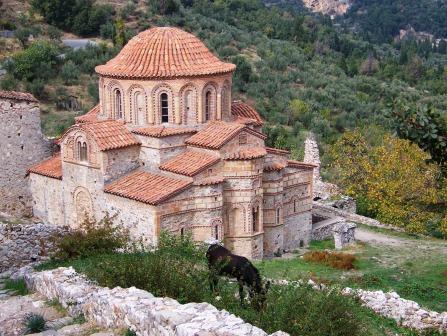
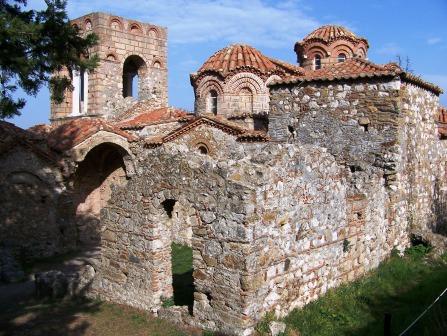
There are about a dozen churches and chapels scattered around the town.
A few of the medieval mansions survived, built of sturdier stuff than most houses. Even these are mostly in ruin, though.
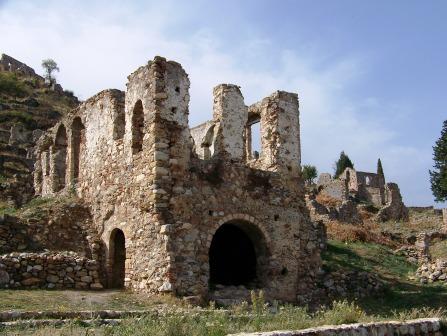

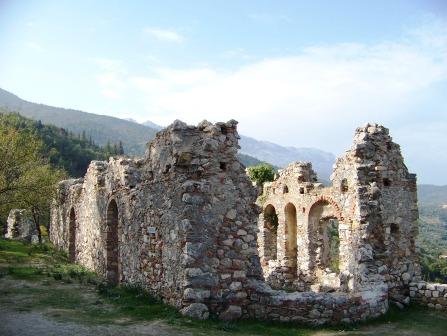

Throughout the town there are all kinds of mysterious openings and stairs and alleyways to explore.

And more wildflowers in bloom!
We hope you can see what a hidden gem Mystras was!
Click here to continue with Monemvasia.